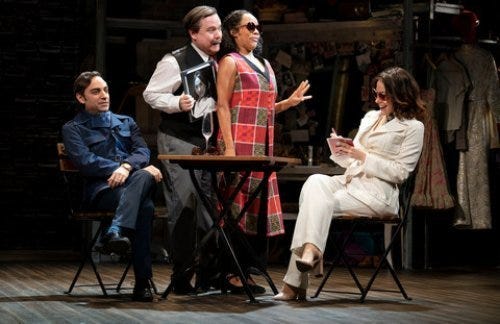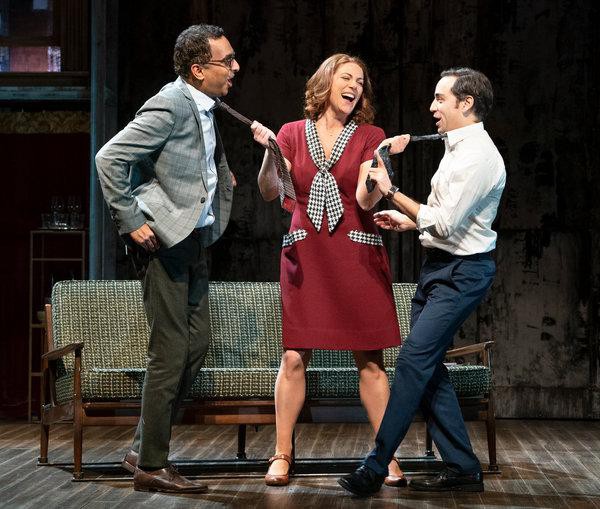Fiasco Theater’s new production at Roundabout expertly deconstructs an imperfect classic and rediscovers the emotional power of the piece.
The Stephen Sondheim-George Furth musical “Merrily We Roll Along,” which tells the story of three friends backwards, has always been polarizing for critics and audience members alike. Famously, its original Broadway production closed after 16 performances, a blasphemous fact for lovers of Sondheim. “Merrily” is certainly a complicated piece — the quintessential example of a great score but an uneven book. Thankfully, Roundabout’s new production at the Laura Pels Theatre by the Fiasco Theater group found the magic within this difficult musical.
Fiasco productions are always experimental, stripped down, minimalist, deconstructed, and ensemble-based, which coincidentally, is perhaps exactly what “Merrily” needed. Something about the musical usually doesn’t work: the characters are unlikeable, it takes too long for the show to click, the transitions between scenes/years are choppy. In this version, Fiasco director Noah Brody has made all the pieces fall into place.
Sondheim has been heavily involved with this production and his touch shows. He and the Fiasco team have made some major changes to the book (including adding some scenes from the original Kaufman and Hart play), brought back a deleted song, changed some keys, and dramatically re-orchestrated for a new pit and a reduced ensemble of only six actors. Gone are the never-ending “Merrily We Roll Along” transitions, the child actor playing Frank Jr., and the beloved overture. Despite all the cuts, nothing feels missing. Of anything, the show feels more full and developed than ever.
All the changes have clarified the show and have brought it back to its original emotional core. For maybe the first time, a major Sondheim production has prioritized the acting over the singing. Although this is a somewhat controversial choice, since none of the actors here give outstanding vocal performances, the emphasis on character, on the book, and on acting through the songs as monologues has made “Merrily” incredibly effective, emotional, and evocative.

Our three old friends are Jessie Austrian as Mary, the author turned drunk art critic, Manu Narayan as Charlie, the family man lyricist, and Ben Steinfeld as Frank, the composer producer extraordinaire. At the top of the show in 1980 they are all at their worst: drunk, lonely, rich and having affairs. But as the show rewinds — quite literally thanks to ingenious staging and choreography by Lorin Latarro — we get to see how everything went downhill. This production, which unlike the original is only one act, is strongest towards the end, where we see the three friends’ youthful naivety and struggles for initial success. “Opening Doors” and “Our Time” have never felt so emotional and heart-wrenching (especially for this twenty-something writer). The cast was rounded out by Brittany Bradford, Emily Young, and Paul L. Coffey, who each played multiple roles but regardless gave consistently strong performances.
In addition to the gorgeous (and sometimes hilarious) rewinding sequences, the show has several other inspired moments of staging, including an ensemble of three actors holding ridiculously costumed scarecrows for “The Blob” song. When in doubt, the production leaned into the camp, embracing the stripped down nature of this version. The set, designed by Derek McLane, was an old theater, filled to the brim with props, sets, and costumes that created gestures of settings for each scene; it created a perfect atmosphere that implied locales without being excessive, true to the Fiasco style of clever minimalism.

For many, “Merrily” simply doesn’t work. They claim the show is just a backward-moving gimmick, the characters aren’t developed enough, and the book is a mess. Certainly I would not say that this is a perfect musical, but I will say that this is a perfect production. The Fiasco ensemble here has found every part of what makes “Merrily” such a powerful piece: the youthful enthusiasm, the well-intentioned bad life choices, the forming and decaying of relationships, and most presciently, the critique of Broadway’s capitalist obsession with profits over art — which in this production has a poignant irony.
Nothing about “Merrily We Roll Along,” especially this Fiasco version, is about being a big money-making musical, it is all about the art; this is exactly the type of show that a young Charlie and Frank want to write. To any fan of Sondheim and to any lover of deconstructed classics, go see this production. To anyone that has ever struggled with “Merrily” — I promise this will change your mind and you will leave with a newfound appreciation for it. This production is nothing short of genius; it is beautiful and inspired, well-thought out, and extraordinary. This is without a doubt the best “Merrily We Roll Along” yet.






